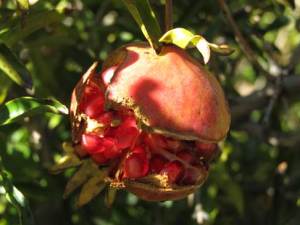Butternut Squash, Kale, and Pomegranate
/Butternut squash, kale and pomegranates are foods of the season. This year I am making the effort to enjoy them more frequently.
 My grocery store has tubs of chunked butternut squash that makes it very easy to cook just the amount I want. I buy the largest they have and freeze what I am not cooking immediately. Butternut squash cooked in broth - mashed when it is tender - makes a great base for a hearty soup. Adding some dried onion, pepper, basic and bacon bits is delicious. One time I added a few spoonfuls of cranberry orange relish and dried parsley just before pouring it into the soup bowl; the tartness of the cranberries and orange contrasted with the squash (and the red flecks of cranberry made the orange soup even more colorful. Another cooking method is to coat the chunks with olive oil and cinnamon then bake in the over. Since the chunks are relatively small - it takes less time than a potato or whole squash.
My grocery store has tubs of chunked butternut squash that makes it very easy to cook just the amount I want. I buy the largest they have and freeze what I am not cooking immediately. Butternut squash cooked in broth - mashed when it is tender - makes a great base for a hearty soup. Adding some dried onion, pepper, basic and bacon bits is delicious. One time I added a few spoonfuls of cranberry orange relish and dried parsley just before pouring it into the soup bowl; the tartness of the cranberries and orange contrasted with the squash (and the red flecks of cranberry made the orange soup even more colorful. Another cooking method is to coat the chunks with olive oil and cinnamon then bake in the over. Since the chunks are relatively small - it takes less time than a potato or whole squash.
 Kale is a new vegetable for me. It is a hardy plant that thrives as the temperatures get cooler. This is my first year to experiment with kale chips. They are tasty and easy to make; simply cut up the leaves (discard the tough central stem), coat/spray with oil, season, cook for about 15 minutes at 350 degrees. I’m still experimenting with ways to avoid getting them too oily (spraying is probably better than putting the leaves in a gallon Ziploc with the oil and seasoning)….and trying different seasonings.
Kale is a new vegetable for me. It is a hardy plant that thrives as the temperatures get cooler. This is my first year to experiment with kale chips. They are tasty and easy to make; simply cut up the leaves (discard the tough central stem), coat/spray with oil, season, cook for about 15 minutes at 350 degrees. I’m still experimenting with ways to avoid getting them too oily (spraying is probably better than putting the leaves in a gallon Ziploc with the oil and seasoning)….and trying different seasonings.
And finally -- the pomegranate. I simply cut the fruit in quarters and enjoy every red-jewel seed. They are a food that is beautiful and tastes good too - a worthy fruit to enjoy fresh and celebrate the bounty of the season!


























